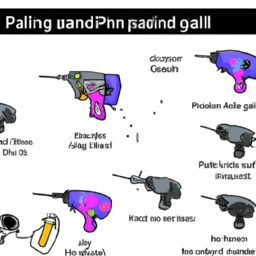How Does A Paintball Gun Work Exploring Mechanics
How Does A Paintball Gun Work
How Does A Paintball Gun Work?
The inner workings of airsoft and paintball guns have always been a source of fascination for shooting enthusiasts. Paintball guns, in particular, are engineered to propel round plastic projectiles filled with paint at high speed. In this article, we'll explore the basics of a paintball system, how it works, and how you can optimize your firing accuracy and performance.
A Paintball Gun &amsb; It's Components & Functions
A paintball gun is a sophisticated weapon, comprising of several parts that work together to shoot the projectile.
The marker is the overall name for the paintball gun and the primary component of the system. It is comprised of an air chamber that stores pressurized gas, a valve, an aluminum barrel and the trigger mechanism.
The gas is typically CO2, but some paintball guns use compressed air. This gas is released when the trigger is pulled, allowing it to push the ball forwards out of the barrel.
The stock barrel is designed to reduce the paintball's exit speed and avoid the paint breaking as it leaves the gun. Some players opt for an aftermarket barrel with an improved design in order to increase their shooting performance.
Safety & Maintenance of a Paintball Gun
Aside from ensuring that your paintball gun works correctly, there are some safety and maintenance precautions to consider. Due to the nature of the system, it's important to inspect your system regularly to ensure that no gas or paint is leaking from the gun. This leak detection is done by firing the gun in semiautomatic mode and then moving your head back quickly to detect gas residue.
You should also check any protective equipment for signs of damage or wear, as well as any O-rings in your marker. Very often, a replacement O-ring is all that is required to restore your paintball gun to a useable condition.
Upgrading a Paintball Gun
Oftentimes, paintball playing enthusiasts may want to improve the system in some way. Some potential upgrades include using a longer, higher diameter barrel or adding an electronic trigger for improved shooting accuracy.
The effective range is the distance at which a paintball gun can shoot the projectile accurately and is often affected by the angle of the barrel and the size of the paintball. For the best firing accuracy, you can opt for a stainless steel or ceramic barrel to reduce wind resistance, keeping the paintball in its original flight path.
Types Of Paintball Guns
Paintball guns are commonly divided into two types mechanical and electro-pneumatic. Mechanical paintball guns use a lever-piston system to compress air inside a sealed chamber and fire the paintball, while electro-pneumatic markers use NE cells and a microcontroller to fire the paintball.
Some players prefer electro-pneumatic systems since they offer more control over the firing process and generally provide better accuracy. However, mechanical guns may be considered a cheaper and useful alternative.
Choosing a Paintball Gun
The selection of a paintball gun depends on a variety of factors, such as the type of game you're playing, the terrain, your style of play, and your skills as a shooter.
For instance, if you're playing in a close quarters environment, such as a small forest, then you'll likely want to opt for a compact, lightweight gun. On the other hand, if you're playing in a more open area, then you might consider a more powerful marker. Clearly, the type of paintball gun you select is largely dictated by the environment.
In Summary
Paintball guns are designed to make shooting projectiles accurately and quickly. As with any other weapon, there are a number of safety precautions and maintenance procedures to consider when using these guns. Additionally, there are a variety of upgrades that can be installed on these weapons to improve their accuracy and reliability. Ultimately, the choice of a paintball gun should be tailored to the surrounding environment, type of paintball playing, and one's own shooting skills.
We hope this introduction has helped explain some of the basics of a paintball gun. For more information on how to use, maintain, and upgrade these weapons, we recommend the reader to consult the resources outlined in this article.
References:
1. https://www.actionvillage.com/blogs/news/choosing-a-paintball-gun
2. https://www.paintball.net/guns/maintenance/
3. https://www.wikihow.com/Optimize-Your-Paintball-Gun
4. http://www.popularmechanics.com/adventure/sports/a8746/paintball-science-guns-hoppers-air-tanks-14794724/

Previous Page
Next Page
